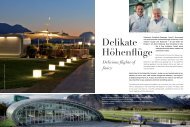Hans-Joachim Pahnke Book
You also want an ePaper? Increase the reach of your titles
YUMPU automatically turns print PDFs into web optimized ePapers that Google loves.
14 15
The introduction of the hydraulic oil drive
For the drive, Hans-Joachim Pahnke changed to oilhydraulics
using the “RP“ type radial piston pump constructed
by him and WEPUKO and control valves he
designed and built. The control valves followed the
principle of a sliding spool valve with two or three positions.
Valves of this type were constructed over the
course of the years up to a nominal diameter of DN
250 mm for an 80 MN press. Electro-hydraulic directional
control valves with adjustable control throttles
were first used as a pre-control, in order to make the
switching time of the spool adjustable. The middle position
of a three-way spool valve was achieved with
Typical three-way
SACK-type spool valve
three different control pistons, which acted on the
main spool.
With the arrival of electro-hydraulic servo valves (EMG
type) and displacement sensors connected to the pistons,
simpler settings for the positions and the acceleration
and deceleration time of the spool was made
possible, which further improved the function of press
control. Furthermore, a main advantage was that hydraulic
oil systems were more cost-effective than water
systems. In addition, the oil drive did not require as
much space.
The first open die press of this type was supplied to the “Mannheim“ forge
in 1961; it has a pressing force of 6.3 MN and an oil drive with an “RP“ radial
piston pump made by WEPUKO-Hydraulik. This press was sold to the “Vorländer“
company, in Siegen in the seventies, where it is still in use.
Competitors generally reacted negatively
to the hydraulic oil drive system from
SACK for open die presses. A major subject
of criticism was the alleged risk of
fire from the oil. Considering the fact
that water presses at that time lost a
considerable amount of water in the
pumping and valve stations, as well as at
the working cylinders, this was an argument
that needed to be taken seriously.
The imagination that open die presses
with oil drive would lose a comparable
amount of oil was initially difficult to
counter. However, because all the working
cylinders of the press were under
the floor and hence below ground level,
the risk of fire could be minimized by the
nature of the construction alone.
Radial piston pump RP, around 1962













